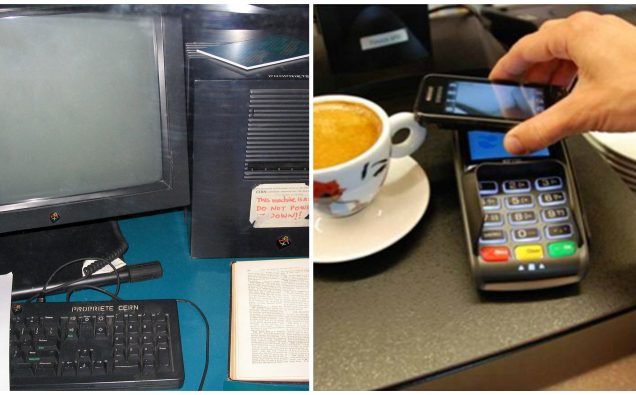
Photo Credit: Computer by Coolcaesar and Cell Phone By HLundgaard both via Wikimedia Commons
While content-rich Internet has changed the way many people live, communicate and do business in advanced countries and urban centers, yet its benefits are unavailable to over half of the world’s population.
According to Measuring the Information Society Report 2016, this year “people no longer go online, they are online,” and almost all the countries made progress toward expanding communication technologies.
“Yet many people are still not using the Internet, and many users do not fully benefit from its potential. A better understanding is needed of who is online and who is not, and how people are using the Internet, in order to create a more inclusive information society,” the report released by the International Telecommunication Union says.
Moreover, the offline population – 3.9 billion people globally – is disproportionately female, elderly, less educated, lower income and rural.
The report argues that in order to bring more people online, it is important to focus on reducing overall socio-economic inequalities. Education and income levels are strong determinants of whether or not people use the Internet.
“To bring more people online, it is important to focus on reducing overall socio-economic inequalities,” said ITU Secretary-General Houlin Zhao.
“Education and income levels are strong determinants of whether or not people use the Internet. ICTs will be essential in meeting each and every one of the 17 Sustainable Development Goals (SDGs), and this report plays an important role in the SDG process. Without measurement and reporting, we cannot track the progress being made and identify areas that require action, and this is why ITU gathers data and publishes this important report every year.”
According to ITU data, the Republic of Korea tops the IDI rankings in 2016 for the second consecutive year.
Here are some of the key findings of the report:
Many people still do not own or use a mobile phone. Household data from developing countries show that a significant part of the population does not use mobile-cellular services at all. In developing economies where recent household data is available, close to 20% of the population, on average, are still not using a mobile phone. Most people who do not own or use a mobile phone are among the youngest (5-14 years old) and those more than 74 years old segments of the population. Usage and ownership penetration rates amongst these age groups are much lower than amongst the rest of the population. Among the 15-74 age group, 85% or more of the population owns or uses a mobile phone in the countries where data are available. But this is changing.
Affordability is the main barrier to mobile-phone ownership. It is the cost of the handset, rather than the cost of the service itself, which is often reported as the main barrier to owning a mobile phone. Another important barrier is the lack of perceived benefits. In communities where overall mobile uptake is low, mobile phone use is perceived to have fewer benefits since fewer community members are also using this mode of communication. Other barriers include lack of ICT skills necessary for accessing the Internet through a mobile phone.
Asia and the Pacific has the lowest average purchasing power parity (PPP) $ price for mobile-cellular services of all regions. The region is home to countries with the lowest mobile-cellular price baskets worldwide: Sri Lanka and Bangladesh, where prices stand out at PPP$ 2.45 and PPP$ 4.14 per month.
Fixed-broadband prices continued to drop significantly in 2015 but remain high – and clearly unaffordable – in a number of LDCs. Globally, the price of a basic fixed-broadband connection has fallen from around USD 80 per month in 2008, to USD 25 in 2015, corresponding to a drop in the ratio of price to average GNI p.c. from over 90% to 14%. In LDCs, a fixed-broadband plan with a minimum of 1GB of data per month still corresponds to over 60% of GNI per capita.
Mobile-broadband is cheaper and more widely available than fixed-broadband, but still not deployed in the majority of LDCs. Globally, handset-based mobile-broadband prices have fallen from an average of PPP$ 29 per month in 2013 to PPP$ 18 in 2015.
Europe continues to lead the way in ICT development. It had the highest average IDI value among world regions (7.35). Countries in Europe generally have liberalised communications markets with high levels of ICT access, use and skills.
A number of countries in the Americas significantly improved their performance in the IDI. Several countries in Latin America, notably Bolivia and Mexico, also made noticeable progress in their IDI performance. Similar to other regions, the growth of mobile-broadband subscriptions was particularly influential on these outcomes.
There is great diversity in ICT development across the Arab States. The five highest performing countries in the Arab States region are oil-rich high-income economies, but the region also includes a number of low-income countries, three of which are LCCs. This illustrates that the digital divide between the LCCs and the more prosperous countries in the region may be growing.
Africa is working on pushing up its IDI performance. The average IDI 2016 value for the Africa region was 2.48 points, just over half the global average of 4.94. The majority of the 39 African countries in IDI 2016 are LDCs. This reflects the lower level of economic development in the region, which inhibits ICT development. The highest growth achieved was in the number of mobile-cellular subscriptions, in contrast to other regions, in which the number of mobile-broadband subscriptions experienced the highest growth.
















